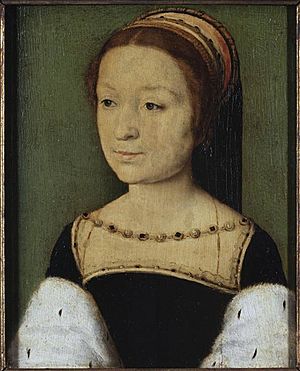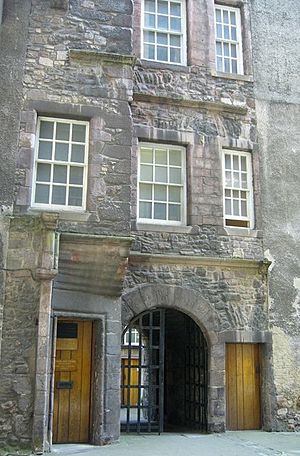Food and the Scottish royal household facts for kids
Some of Scotland's old royal palaces, even in ruins, still show us where food was cooked, served, and stored. We know a lot about the royal kitchens in the 1500s because of old records. These records, like the Liber Emptorum and Liber Domicilii, were daily lists of food and drinks bought for the royal family. Back then, about 60 people worked in the royal kitchens!
Supplies for the royal household were called "furnishing." Important people like the Masters of the Household usually managed them. When King Charles II came to Scotland in 1650, new Scottish staff were hired to look after him. Records of food and spices from his stays at Falkland, Stirling, and Perth still exist. He might have even stayed in the old Gowrie House in Perth.
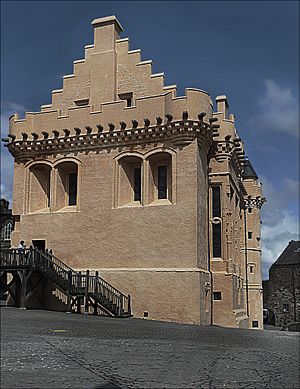
Contents
Royal Kitchens and Food Prep
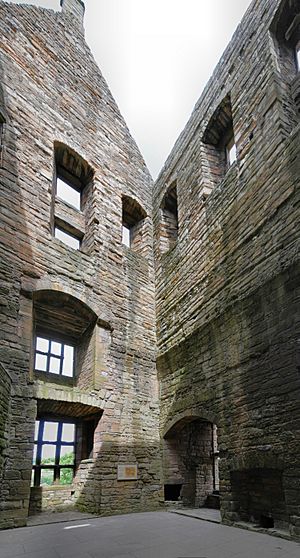
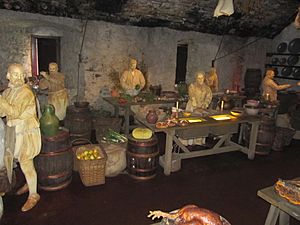
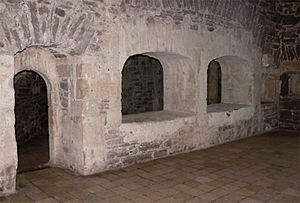
We don't have lists of kitchen equipment from the 1500s. But we know that large chests, called "great kists," were made for storing food and silver dishes at Stirling Castle in 1532. Carpenters also built a special area called the "kitchen dressory." This is where food was arranged on plates before being served. They made an oak table, a frame for the serving hatch, and a chest for dried salmon. Gardeners even grew lettuce and thyme for the kitchen!
In 1525, the king's kitchen bought two iron frying pans. New pewter dishes were also bought for Christmas, including four large plates for the king's table. Murdo Stirling, who was the pastry chef (pâtissier) for Mary of Guise, bought four waffle irons in 1539. He also helped install ovens on the king's ships, like the Salamander, for a trip to Orkney.
At Holyrood Palace, a new stone oven was built in 1532. Its floor was made of special tufa stone from North Berwick. The kitchen roof had a "louvre" (a ventilation opening) that looked like a beehive to let out smoke. Mary, Queen of Scots used coal for her own rooms. The kitchen ovens probably used wood and charcoal. In 1505, James IV gave land with a coal pit to his master cook, Thomas Schaw. Thomas was expected to deliver coal to Linlithgow Palace.
Some kitchen tools were listed in an inventory of weapons at Edinburgh Castle in 1567. This might have been for a kitchen used by the castle's gunners. It included an iron grill, two iron racks, two spits for roasting, and two tables for preparing food. The new bakehouse had a baking board, a storage chest, and a trough. Hand-mills for grinding wheat were in a cellar. A brewhouse had a large vat for brewing beer, a kettle, and other containers.
More kitchen items were listed in 1562 for the Earl of Moray, Mary, Queen of Scots's half-brother. These included skimming ladles, frying pans, roasting irons, pestles and mortars, knives, a coal rake, and pewter plates.
Royal Silverware
James V owned many silver and silver-gilt items for his table and for display. In 1531, he got silver plates from Nicholas Cannavett, a French official. These included square plates with salt containers in the corner. These were at Edinburgh Castle in 1543, along with other treasures like a silver cup said to have belonged to Robert the Bruce. Mary, Queen of Scots, took silverware with the royal crest to France in 1548 for her special kitchen.
James V also had two silver-gilt ship models (called nefs) for his table. His grandson, James VI, sent them for repair to a goldsmith in The Canongate in 1602. Some royal silver was melted down by Regent Moray in 1567. In 1589, James VI got a cup made from an ostrich egg set in silver. In 1590, the master of the wine cellar, Jerome Bowie, and the master of household, Andrew Melville of Garvock, made a list of all the old and new silver kept in the cuphouse.
Linlithgow Palace Kitchens
The kitchens at Linlithgow Palace are spread across three levels in a tower. They were changed in 1464, 1470–71, and 1539. Some changes were due to the ground sinking. The main court kitchen is next to the Great Hall. The room beside it was probably where spices were kept. In 1539, James Hamilton of Finnart was paid for rebuilding the king's kitchen, adding a fireplace, an oven, a room for silver dishes, and a place for coal. There's also a well in the lower kitchen.
The wine cellar is under the royal living quarters. The palace museum even has an eel fork that was used to catch eels from the nearby loch!
Stirling Castle Kitchens
Old vaulted cellars that served as kitchens at Stirling Castle were found in 1920. These included a bakehouse and a larder for bread. There was also a kitchen area and a "dressory" for preparing food. These areas connected to a corridor that likely led to the Great Hall. James IV had another, separate kitchen in his own lodging, now called the King's Old Building. This area also had a small larder, a pantry, and a wine cellar. James V and Mary of Guise had kitchens in the cellar of the new Palace.
In 1533, a priest named James Nicholson was in charge of building work at Stirling. He also fed cranes, herons, peacocks, and bitterns for the king's dinner table! In 1558, a carpenter made a cupboard for Mary of Guise's kitchen called a "gardemange" (a type of pantry). A mason built a passage from the queen's kitchen to a stairway.
Dunfermline Palace Kitchens
At Dunfermline Palace, you can still see some parts of a kitchen that served both the royal family's hall and the monastery's dining room in the 1400s. There are also remains of a second kitchen that served only the royal family.
Falkland Palace Kitchens
At Falkland Palace, there was a kitchen for the great hall, which is now gone. A bakehouse in a cellar kitchen area had a service staircase that led up to the royal rooms on the first floor. Another kitchen in the gatehouse tower served the palace keeper's living area.
Records from King Charles II's visit in July 1650 show what he ate. His food was seasoned with saffron, nutmeg, cinnamon, cloves, and ginger. Every tart for the king had a pound of sugar, while tarts for other courtiers only had half a pound. A funny story from this time is about a servant of the king's tailor who was caught taking one of the royal napkins and unpicking the embroidered initials!
Holyrood Palace Dining
The old kitchens and Great Hall of Holyrood Palace are gone now. But you can still see the supper room, a small space in the royal bedroom where Mary, Queen of Scots ate with David Rizzio. The day after Lord Darnley died, a servant named "French Paris" came to the queen's room to hang black mourning cloth on her bed and light candles. A lady-in-waiting, Marie, Lady Seton, gave him a fried egg for breakfast, probably cooked on a fireplace in the royal suite.
An English official, John Young, wrote about how meals were served when Margaret Tudor visited Holyrood in 1503. He mentioned some dishes at her wedding dinner on August 8th. The first course included a gilded boar's head on a platter, a large piece of brawn (a type of meat jelly), and ham. Later royal records often mention calf's head and jelly as ingredients for brawn. A full menu for the banquet listed these same three dishes to start. Desserts included "custard royall." Spiced wine called "Hippocras" was made by the apothecary, John Mosman.
The Earl of Atholl's Big Banquet
A story written by Robert Lindsay of Pitscottie in the 1570s describes a huge banquet. The Earl of Atholl prepared it for King James V to impress an ambassador from the Pope. This event probably happened in 1532 in a temporary wooden lodge built like a castle in Glen Tilt near Pitlochry.
Pitscottie said the banquet had:
- "all manner of meats (foods), drinks, delicacies that was to be gotten at that time in all Scotland."
- Drinks like ale, beer, white wine, claret, malvassy, musticat, allicant, hippocras, and aqua vitae (strong alcohol).
- Foods like white bread, gingerbread, beef, mutton, lamb, rabbit, crane, swan, wild goose, partridge, plover, duck, turkeys, peacocks, black cock, moor fowl, and capercaillies.
- The moat around the palace was filled with fish like salmon, trout, perches, pikes, and eels.
- There were skilled stewards, bakers, cooks, and pastry chefs for desserts.
The royal family often went on hunting trips. Food was brought from other places. Since the 1400s, there was a Hunt Hall in Glen Finglas for the royal party. James IV visited in 1492. In 1505, he got dairy products from two women and eels and pikes from the Lake of Menteith. In 1538, James V and Mary of Guise went to Glen Finglas with six ladies-in-waiting, bringing food bought in Stirling. Mary, Queen of Scots, spent three days there in 1563. James V also hunted deer near Comrie in 1532, bringing bread, ale, and fish from Stirling.
Royal Records and Daily Life
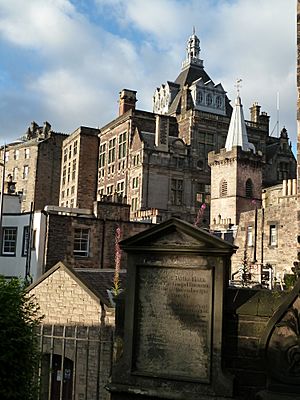
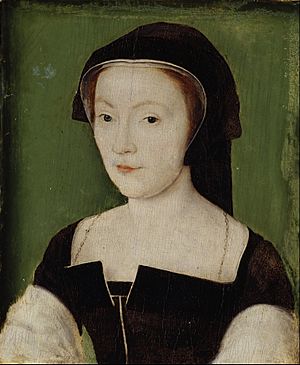
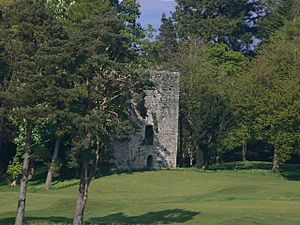
Records of wages for royal kitchen staff can be found in the comptroller's accounts. These also include some food purchases. For example, James IV provided a ship for Perkin Warbeck's servants with mutton, barrels of salmon and herring, and dried cod. Almost all the named kitchen workers were men, except for the linen laundress, Margaret Musche, in 1496. In 1507, two swans costing 12 shillings were bought for a feast.
One comptroller, James Colville, was fired in 1538. He was made responsible for a large amount of wax, spices, and other goods supplied to the household. The next comptroller, David Wood of Craig, noted that suppliers could sometimes claim payment multiple times because the royal accounts weren't well organized.
Household books from the reign of James IV (1511) until 1553 still exist. These are written in Latin and list daily food purchases. They also include "uncosts," which were extra purchases like cord to hang poultry. In 1511, James IV hosted a Christmas banquet for a French ambassador. Lamb, piglets, quail, plovers, snipe, young rabbits, and a lot of calf's foot jelly were served.
These household books also noted where the monarch was each day. This helps historians track royal travels and important dates. For instance, on June 11, 1533, James V went on a pilgrimage to St Ninian at Whithorn for a week. On March 1, 1539, James was in Edinburgh and attended the trial and burning of people accused of heresy.
The books also list food for hunting trips, wedding feasts, banquets on the royal ship Great Michael, table linen, and soap for laundry. Sometimes, the monarch had afternoon drinks, especially during hunting. Ginger and pepper, and linen for the cook, were supplied to James V by Michael McQueen. He and his wife, Janet Rynd, founded the Magdalen Chapel in Edinburgh.
The royal family ate salted Orkney beef, mutton, calves' heads, and ox feet. Lamb's intestines bought for a feast at St Andrews to welcome Mary of Guise to Scotland were probably used to make a type of haggis. They also ate many kinds of fish and seafood, including mackerel, Loch Fyne herring, conger eel, dried whitings, whale, and porpoise. Poultry and birds included moor hens, dotterel, swans, quails, and capercaillie. Rabbits came from special warrens, and baked baby rabbit was a special treat. Fridays were fish days. The records also mention claret wine, local ale, and imported German beer. James V got ale from women in North Berwick when he visited Tantallon Castle.
At Easter in 1526, when he was 14, James V gave ale and 14 loaves of bread to poor people in Edinburgh. His cooks from 1525 were Hugh Johnston and Walter Gardener. In 1533, Thomas Marschall was in charge of shopping during the king's visit to Perth and later became head cook.
When James V returned from France with his bride Madeleine of Valois, he brought barrels of olive oil, verjuice (sour grape juice), claret and white wine, and a huge amount of salted lard. This showed his interest in French cooking. In 1537, Madeleine was ill. English spies claimed the king "doth keep so small an house that there is but only six messes of meat allowed in his house" (meaning he had a very small household). Many Scottish food words come from French.
In 1539-1540, the king's money manager's accounts show rewards given to servants who brought food gifts. Henry Wardlaw sent a boar, and Lady Erskine sent lampreys (a type of fish). When the king and Mary of Guise were at Ravenscraig Castle, they ate pikes and eels from Loch Leven. The Earl of Huntly brought aqua vitae and venison to Falkland. James V also ate pike from the Lake of Menteith and bream from Lochmaben. His favorite, Oliver Sinclair, brought 196 rabbits for Christmas 1539.
In March 1549, whales that washed ashore near Cramond Island were salted and packed in barrels. Regent Arran had four barrels sent to Seton Palace. Whale oil was also bought for Edinburgh Castle. Washed-up whales were very valuable.
After a war called the Rough Wooing, Regent Arran hosted a banquet in Edinburgh on May 21, 1550. It was for Claude, Marquis de Mayenne, who had been held hostage in England. The dining hall was decorated with royal tapestries. Benches and stools were covered in green cloth and purple velvet. A new outfit was bought for Elizabeth Murray, who served or performed at the feast.
Mary, Queen of Scots's Food
Similar records exist for Mary of Guise and Mary, Queen of Scots, written in French. These records also help track where the queen traveled. For example, on January 9, 1540, Mary of Guise had dinner at Burleigh Castle and supper at Falkland Palace. Beef, mutton, goose, plovers, and partridges were on the dinner menu. At Falkland, there was beef, mutton, pork, poultry, and rabbit. The pastry chef made partridge pie, a pasty of pig's trotters with a special sauce, and craquelin (a type of biscuit).
At this time, Mary of Guise paid for her household's food from her own money. A "Bread book" from 1549 lists how much bread her courtiers and staff received. After the Scottish Reformation in 1561, some household expenses were paid for by "thirds of benefices" (money collected from church taxes). Much of the food collected this way was sold, and wine and cheese were bought with the money. But some wheat went directly to Mary, Queen of Scots's bakers. John Huntar kept sheep and cattle in Holyrood Park to feed the household.
When Mary visited Rossdhu and Dumbarton Castle in July 1563, fish was served on Saturday, July 17th. This included two salted salmon, two salted ling, 50 trout, and 36 plaice, cooked in 16 pounds of butter. Her household book was checked and signed by her former French comptroller, Bartholomew de Villemore. Her supplier, Alexander Durham, collected money from Coupar Angus Abbey in 1564 to help pay for a hunting trip to Glen Tilt, where her father, James V, had been honored with a banquet.
The word "marmalade" comes from a Portuguese word for quince, not from "Mary" and "malade" (sick). Mary certainly enjoyed a quince preserve called "cotignac" in France. Before her son Prince James was born in June 1566, she received a gift from Flanders that included "banqueting dishes of sugar and marmalade."
One cook, Nicholas Boindreid, had a relationship with a woman in The Canongate. Estienne Hauet and his wife continued to cook for Mary when she was imprisoned at Lochleven Castle. The queen's food at Lochleven was provided by James Dempsterton, a servant of the Laird of Lochleven. Estienne and Martin Hauet rejoined Mary's household in England in 1569.
James VI and Anne of Denmark's Meals
Food allowances for James VI as a baby at Stirling Castle in 1568 were set by Regent Moray. Annabell Murray, Countess of Mar and her servants were to receive:
- Daily: 14 large breads, 1 quart 1 pint wine, 1 gallon 2 quarts ale.
- Weekly: 3 loads of coal in winter (September to April), and 1.5 loads in summer.
- Daily: Half a pound of candle in winter, and a quarter of a pound in summer.
- On meat days: 2 pieces of beef, 2 boiled poultry, 2 roast capons, 3 quarters of mutton, a kid, a side of veal, 6 chickens or doves, with baking meat and pottages (stews).
- On fish days: Similar amounts of fish dishes.
James VI often wrote to his nobles and landowners asking for gifts of food, especially meat and game, for special occasions. He often said it was for "national honor." For example, he asked Robert Murray for "venison, wild fowls, fed capons" for a wedding at Holyrood in 1588. In 1589, before his bride Anne of Denmark arrived, he asked the Laird of Arbuthnott and Sir Patrick Vans to provide "fat beef, mutton on foot, wild fowls and venison."
When James VI sailed to Norway to meet Anne of Denmark in October 1589, his ship was stocked with 15,000 biscuits, beef, mutton, salted goose, rabbits, capons, 200 dried cod, 200 ling, 200 skate, two barrels of salmon, cheese, sugar, confectionery, ginger, pepper, apples, onions, vinegar, 20 large hams, kale, carrots, 180 live capons (with oats to feed them), sack wine, and Madeira wine.
In February 1590, James VI wrote from Kronborg Castle, urging his Privy Council to prepare for his return. He said, "a King of Scotland with a newe married Wife will not come hame every daye... Faile not to provide gude Cheare for us, for we have heir aboundance of gude Meit and part of Drink" (meaning, "Don't fail to provide good food for us, because we have plenty of good meat and drink here").
At Stirling Castle in 1594, eight noble women attending Prince Henry received daily allowances for dinner:
- On meat days: A piece of beef, two pieces of boiled mutton, a boiled fowl, with six dishes of pottage. Their second course had 12 dishes of roast meat.
- On fish days: 12 dishes for the first course, including prunes, rice, butter, eggs, fried toast, milk and bread, peas, oysters, green kale. The second course had 8 dishes depending on the season, and desserts like eggs, raisins, confectionery, and apples.
As was common, the servants who waited on these ladies, and other staff, ate the leftovers. There were also separate tables for the nurse, the women who rocked the cradle, physicians, and the midwife.
For the feast at Prince Henry's baptism at Stirling Castle in August 1594, James VI asked landowners to send "quick stuff" (live animals), especially deer and wild fowl. The banquet included a dessert course of sugar fish made by a Flemish sugar confectioner, Jacques de Bousie. These were served in the Great Hall from a model ship with working cannons! The sugar fish were presented in glasses. The poet William Fowler described the scene, saying the sugar ship represented the king and queen's good fortune and her safe delivery from "witches."
In March 1595, James VI asked Sir Robert Cecil and Elizabeth I for a gift of English beer for Stirling Castle and Holyroodhouse. For the baptism of Princess Elizabeth in 1596, James VI asked for "wild meat and venison" from various nobles and lairds.
Records for James VI and Anne of Denmark from 1598 still exist. They are written in the Scots Language and detail the wedding feast of Anne of Denmark's preacher and the visit of Ulrik, Duke of Holstein. The queen's accounts were sometimes signed by the master of work, William Schaw.
The town of Edinburgh hosted a banquet for the Duke of Holstein at Ninian MacMorran's house on May 2, 1598. The queen's cook, Hans Poppilman, was hired, and tableware and tapestries were borrowed from Holyrood Palace. Wine was sweetened and spiced to make hippocras by two apothecaries. On May 22, 1598, James VI drank all night with the Duke of Holstein. On June 19, his birthday, James VI had supper at Crichton Castle after a day of hawking.
The baptism of Prince Charles was held in December 1600 at Holyrood Palace. This time, James VI asked Walter Dundas for venison, wild meat, "brissel foulis" (turkeys), and capons as his contribution to the "great provision and cheer."
Anne of Denmark had Danish kitchen staff, including a cook named Marion. James VI was supplied with shortbread and oatcakes by Christian Lindsay, who was also a poet.
Grand Banquet in Edinburgh, 1617
James VI returned to Scotland in 1617 for a visit, leaving Anne of Denmark in London. There were huge preparations. Silverware and fancy tablecloths were sent ahead. The Privy Council asked Gideon Murray to plan how to pay for feeding the royal party and for providing "wheat, beir, oats, wine, spices, beef, mutton, and other provisions" to the royal houses. He created a special tax. Country landowners were asked to send produce. John Grant was asked to provide capercailzies and ptarmigan (types of game birds).
Edinburgh hosted a banquet for King James in a special building in the Council House Yard. The king's jester, Archibald Armstrong, was paid a large sum. There was French and Rhenish wine, sack wine, ale, and beer. An Italian expert arranged the table linen. 500 oranges were used to make a dessert with strawberries and cream. The main courses were venison and poultry. After the feast, the visiting courtiers danced through the town. The cost of this entertainment was almost six times more than the banquet at Riddle's Court in 1598.
When Charles II was in Scotland in 1650, spices were bought in December for Christmastime. These included "scrotckets and confects," which were sugar treats. A 'scorchet' was a sugar sweet flavored with rose water, known to be served at Scottish celebrations since the 1400s.
Masters of the Royal Household
The Master of Household was in charge of the budget and buying food for the royal family. Margaret Tudor's household also had an administrator called the "Great Purveyor."
David Beaton and Harry Lindsay were masters of household for Anne of Denmark. In 1591, they complained about missing food allowances for ladies-in-waiting and other courtiers, including Marie Stewart, who deserved breakfast because she was a "tender bairn" (a delicate child). At this time, many ideas were suggested to reduce the cost of food for both royal households. It was reported that the king's and queen's tables sometimes almost went without food because of shortages. After calculating costs, the Masters of Household were told not to spend more than £900 a year on spices for the queen and no more than £1500 on sugar, sweets, almonds, oil, and lard.
Servants and skilled workers who joined the royal households were given food allowances based on their rank. These allowances were often listed in tables of servants who ate together, like Anne of Denmark's Danish servants. In 1602, the embroiderer Thomas Barclay joined her household at Dunfermline Palace. She wrote to her Master of Household, Patrick Hume of Polwarth, asking him to give Barclay meat, bread, ale, candles, and coal. This allowance was called an "ordinar."
Office holders included:
- James Anstruther
- Gilbert Balfour of Westray
- David Beaton of Melgund
- Robert Beaton of Creich
- Alan Cathcart, 4th Lord Cathcart
- John Campbell of Lundy
- Mungo Graham of Rathernis (died 1589)
- Matthew Hamilton of Milnburn
- Patrick Hepburn, 1st Earl of Bothwell
- Patrick Hume of Polwarth
- Harry Lindsay of Carrestoun
- Patrick Lyon, 1st Lord Glamis
- Andrew Melville of Garvock
- Robert Sempill, 3rd Lord Sempill
- Bartholomew de Villemore




